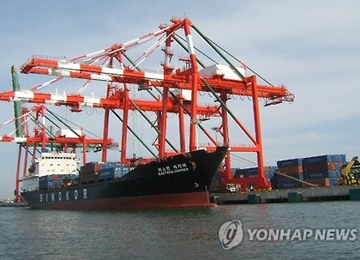Korea struggles to reverse decline in exports
By Kim Kyung-ho
Korea has seen its exports declining for 14 months in a row since January last year. The record streak of on-year monthly decrease — with double-digit figures for the December-February period — has amplified concerns over the slowing growth of Asia’s fourth-largest economy heavily reliant on exports.
What is being closely watched for is official trade data for March, which is set to be released by the government Friday.
With the country’s outbound shipments certain to decrease for a 15th consecutive month, trade experts and the media are paying attention to whether the pace of decline will decelerate to a single digit.
Government officials have lately suggested March will see an improvement from the performance in February, when exports fell by 12.2 percent from a year earlier, following an 18.8 percent drop in January.
“We are determined to reverse the trend of double-digit declines into single-digit decreases as early as possible,” said Joo Hyung-hwan, the minister of trade, industry and energy, last week.
Speaking to reporters during a field trip to provincial industrial complexes, he expected the pace of the decline in Korea’s exports to slow down the road thanks to rebounding oil prices and stabilizing exchange rates.
He might also have wanted to cite the strenuous efforts he has made to support local exporters since he took office in January to back up his forecast.
Korea is not the only country to have suffered from a sharp fall in exports over the past year as global trade is shrinking due to tumbling commodities prices, financial market turmoil and slowdown in China and other emerging economies. As some officials here note, its export performance last year — a 7.9 percent decrease — might be seen as relatively better than most other major countries.
But Korea is in no position to be complacent as exports will continue to hold a key to boosting growth especially at a time other stimulus measures are nearing their limit.
Major think tanks and investment banks at home and abroad are putting their 2016 growth outlook for the Korean economy at a range of 1 percent to 2.6 percent, much lower than the 3.1 percent projection made by the government at the outset of the year. The prospect of a continuous fall in exports is cited as a reason for their cautious forecast.
Studies released last week strengthened the case for Korea having to step up efforts to diversify its export items and destinations.
Of the five export powerhouses compared in the study by the Trade Ministry, Korea was the only country whose 10 major export items — including semiconductors, cars, steel and ships — remained unchanged over the past decade. China, Germany, Japan and Taiwan saw changes in their key export items.
A report from the Korea Economic Research Institute showed the 10 products Korean exporters mainly depend on accounted for 45.6 percent of global trade in 2014, down from 48.3 percent in 2011.
Over the period between 2005 and 2015, the share of the 10 major items in Korea’s exports increased slightly from 85.6 percent to 85.7 percent, with corresponding figures for Japan, Germany and Taiwan dropping from 85.7 percent, 71.6 percent and 83.9 percent to 81.7 percent, 70.6 percent and 82.3 percent, respectively. The number for China edged up from 67.0 percent to 67.7 percent.
According to the Trade Ministry, Korea’s dependence on its 10 largest export markets also rose from 65.5 percent to 66.7 percent over the cited period, while all comparable figures for China, Japan, Germany and Taiwan dropped.
Notably, Korea relied on China for more than a quarter of its exports last year, compared with 21.8 percent a decade earlier.
“The country is now running short of time to strengthen the base of exports by diversifying products and markets,” said Byun Yang-gyu, a researcher at the KERI.
Trade policymakers are focusing on getting more small and medium-sized enterprises to ship their products abroad and expanding the outbound shipment of consumer goods that are becoming increasingly popular in foreign markets on the back of the popularity of Korean pop culture.
During his tour of regional industrial parks last week, Joo said support will be strengthened to nurture more than 5,000 first-time exporters this year, hoping to increase exports by SMEs, which account for a third of Korea’s total exports, by 10 percent.
His ministry also announced a set of measures to help export more consumer goods, which take up only 5.5 percent of the country’s outbound shipments, compared with 29.8 percent for China, 26 percent for Germany and 16.7 percent for the U.S.
Joo said Korean companies might find more opportunities in China’s rapidly growing consumer markets despite the slowdown in the world’s s No.2 economy.
The government is also working on measures to help local companies to sell more products in what have been chosen as four new strategic markets — Iran, India, Mexico and Vietnam.
Such all-out efforts need to be further accelerated to reverse or slow the decline in exports in the short run. Experts note Joo and other policymakers should also keep their eyes on structural reforms to reduce overcapacity in uncompetitive sectors and develop new export industries in the long run.
([email protected])


